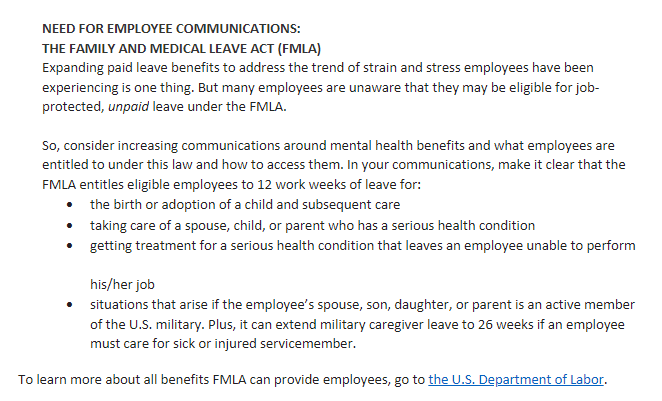2 Years Post Pandemic – What Should Your Benefits Look Like Now?
4 considerations to help keep and attract workersThe major life-shifting events of the past two years have taken a toll on everyone.
In fact, a 2022 Household Pulse Survey conducted by the National Center for Health Statistics found that more than 30 percent of Americans now report symptoms of anxiety or depressive disorder.
More recently, Pew Research found:
28% of workers said the pandemic had impacted their life in a major way
34% said the pandemic and its aftermath are a major threat to their personal financial situation
Yet, industry surveys also show very few seek help. Unchecked, burnout and stress can lead to lower engagement, satisfaction, and productivity on the job, as well as additional health issues.
Almost half (48%) of employees say they’ve experienced burnout since the pandemic.
Source: Workhuman 2022
Does Your Program Offer the Benefits Employees Need?
As open enrollment season approaches, take the time to ensure your employee benefits offer the wellness-related services that can not only help employees manage the mental stress of the pandemic and its lingering impacts, but also helps keep them happy, healthy, and productive going forward.
Here are just a few offerings you may want to consider enhancing or adding to your benefits program:
Mental health services
Nearly one quarter (23%) of workers say their employer offered mental health services since the pandemic, according to a recent Harris Poll. And about 70 percent of them (67%) say they’re beneficial. Among the most common types of mental wellness benefits:
- Employee assistance plans (EAP) which can provide free access to support sessions that help employees deal with lingering struggles brought on by the pandemic, (e.g. sickness, financial stress if a loved one lost their job, uncertainty about emerging variants, etc.)
- Tele-health services which can allow virtual and easy access to professional mental health assistance and/or therapy provided by a network of licensed psychiatrists, psychologists, social workers, counselors, and therapists.
- Mental health coverage under health plans offered so that those suffering from mental health issues, like anxiety and depression, can access support and services.
“Eighty-one percent of workers say that how employers support mental health and wellness will be a factor when choosing a job.” Source: American Psychological Association
Flexible work schedules
This year, more than 90% of employers are planning to adopt a hybrid model for at-home versus in-office work. While this can certainly provide more flexibility to enhance work-life balance for stressed employees, other employers are taking a step further to offer even more flexibility. Some are piloting four-day workweeks. And others are offering flexible policies over how many hours employees work – both of which can bring more relief to employees and have a favorable impact on performance. Is there room in your benefits structure to offer more flexible schedules?
“Organizations that offer employees flexibility over when, where and how much they work, see 55% of their work force as high performers.” Source: Gartner
Expanded time off policy
Employers often encourage their employees to use their paid time off (PTO) to recharge and refresh. Over the past couple of years, some have started to broaden policies to better support the needs of their employees and their families to include things like unlimited PTO and mental health days so that employees can take the time they need away from work. Social media giant, Pinterest, for example, now offers paid leave for up to four weeks to specifically help those employees who may have lost their childcare service or who may now have to care for someone suffering from long COVID, for example.
Not only does adopting unlimited PTO show you care about your employees’ well-being, but it can also help your entire organization reap several valuable benefits, including:
Lower administration costs since there can be less accounting and recordkeeping work that needs to be done when compared to managing traditional accrued PTO policies.
Greater ability to attract new hires to your organization and give you more of an advantage over other employers who may be competing for the same talent.
Increased goodwill and job satisfaction among existing employees, which can translate into more engaged workers, better retention, and, boosted productivity.
Educational resources
To meet employee demand and preference for accessing help whenever and wherever they need it, employers are broadening their suite of benefits to encompass digital mental health solutions, particularly videos, wellness tips, and popular apps, e.g., Calm. Not only can these types of resources supplement your benefits programs, but they can also add a measure of confidentiality and anonymity, which employees tend to appreciate.

Is your benefits program keeping pace with trends?
Now, more than ever, it’s important to keep your benefits program in step with current trends and employee mindsets.
Contact our Employee Benefits team for help structuring a holistic benefits program that can include mental health offerings as part of your benefits program.
This material has been prepared for informational purposes only. BRP Group, Inc. and its affiliates, do not provide tax, legal or accounting advice. Please consult with your own tax, legal or accounting professionals before engaging in any transaction.
Download the Article
2 Years Post Pandemic – What Should Your Benefits Look Like Now?
